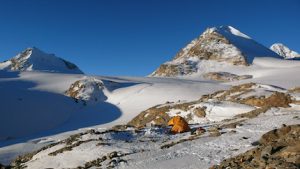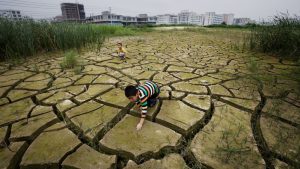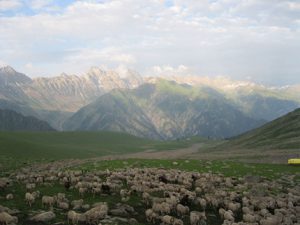Scientists and environmentalists are raising serious safety concerns about a nuclear power plant being built by the Chinese near Karachi, Pakistan’s largest city
Chinese engineers have started to build a nuclear power plant about 40 kilometres from the port city of Karachi, Pakistan’s largest city with a population of around 18 million. Many Pakistani environmentalists and physicists are raising serious safety concerns.
Part of the concern is because two ACP-1000 nuclear reactors – recently designed by the Chinese – form the core of the power plant. China is also providing the enriched uranium that will be used as fuel.
The design is still under development by the China National Nuclear Corporation. No power plant has been built based on this design, even inside China.
Noted physicist Pervez Hoodbhoy is uncomfortable with the new Chinese design. “Buy only those reactors that have been tested for reliability, and have multiple redundant systems so that there are adequate emergency backups,” he said. “Chinese reactors do not meet these criteria.”
There has been no public hearing or discussion about the suitability of the site, nor an environment impact assessment report in the public domain. “Neither the Pakistan Atomic Energy Commission nor the Pakistan Nuclear Regulatory Authority has explained what will happen in case of an accident at the proposed reactor,” said an article in the influential Pakistani newspaper Dawn.
“The health and environmental consequences would be potentially devastating,” said Zia Mian, a leading international physicist at the Woodrow Wilson School of Public and International Affairs at Princeton University.
The reactors are expected to start supplying 2,200 megawatts to the grid by 2019. This is not the first nuclear project in Pakistan, but it will be, by far, the largest in a country gripped by a huge power crisis. In many parts of the country, power outages of up to nine hours a day are routine, causing a colossal loss to industry. The US$9.59 billion nuclear power complex is expected to go a long way in tackling the power shortage.
After the Chashma power plant in Punjab province, this is the second instance of cooperation between China and Pakistan in the field of nuclear energy.
Last month, after Prime Minister Nawaz Sharif inaugurated the nuclear power plant site near Hawkes Bay beach and announced the building of six more nuclear power plants in the presence of officials from the Pakistan Atomic Energy Commission, the scientists’ concerns became more pronounced.
Pakistan unprepared to deal with nuclear risks
Mian said that two and a half years after the Fukushima nuclear disaster in Japan, there is still several hundred tonnes of radioactive water leaking into the ocean every day.
“There are still places on the site where people can get a lethal dose of radiation within hours; the decommissioning of the reactor site is expected to take at least 30 years; some surrounding areas will never be fully decontaminated and so displaced local people may never be allowed to return home,” he explained.
Referring to Fukushima and before that the accident in Chernobyl in Ukraine in 1986, Pervaiz Amir, director of the Pakistan Water Partnership – an organisation under the government’s Planning Commission – warned of catastrophic “immediate and long term consequences for large populations” due to radioactive contamination.
“It is hard to imagine that Karachi city, or Sindh province or even Pakistan as a whole could mobilize the resources to deal with a serious nuclear disaster at the new reactors,” pointed out Mian.
This fear among Pakistani scientists is amplified by the fact that the reactors to be built are close to a population of almost 18 million and in case something goes terribly wrong, there will be no contingency plan.
An environmentalist with the International Union for Conservation of Nature (IUCN), Muhammad Tahir Qureshi, gave the example of the 1971-built Karachi Nuclear Power Plant (KANUPP), which is dysfunctional at present, and by official claims, produces no radiation.
There are no official studies carried out and no clear record of accidents at KANUPP. But, raising questions about the transparency of information on the issue, Qureshi said he has found “the discharge of cooling water into the sea has adversely impacted the fisheries potential as well as the health of the local population.”
He even said the plant’s safety systems were unreliable and could “lead to a major catastrophe, much larger than Bhopal (the chemical plant disaster in India in 1984 that killed thousands), as a result of malfunctioning of the plant and the absence of any contingency plan.”
According to Qureshi, the authorities seem unconcerned about the risks and have done nothing to mitigate any “man-made disaster” or develop community coping mechanisms. These should include “regular drill and awareness raising among national and regional planners, land use planning proposal in project design and appraisal in hazard prone areas,” he said.
Nuclear technology can potentially generate reliable carbon free electricity. But can the industry be developed safely?
Pointing out that there is “no absolute safety”, Mian said, “The question should not be whether any nuclear activity is safe… The questions to ask are: Do you know what all the risks of any given nuclear activity are? How dangerous are the consequences? Who decides that the nuclear risks and consequences are acceptable? How is this decision made? And, finally, are the people who decide about the risks the same ones that have to bear the consequences if things go wrong?”
Most experts showed particular concern as the reactors were being built close to an urban centre. “Locate all nuclear reactors away from population centres,” said Hoodbhoy.
“Place it far away from Karachi and bear the cost of a transmission line but keep human safety as paramount,” said Amir.
How to deal with nuclear waste?
There is also the question of how the spent fuel is stored. According to Mian, the standard procedure is that the hot radioactive spent nuclear fuel from a reactor is taken out of the core on a regular basis and placed in a pool of water to cool – and fresh fuel is put in the reactor.
The pools can hold the fuel from many years of reactor operation. But as time passes, the pools contain much more radioactive material than the reactor core itself. The spent fuel can stay in the pools for several years if there is nowhere else to put it.
Mian pointed out, “A fire in a spent fuel pool could release much more radioactivity than a nuclear reactor accident and so could have much worse health and environmental impacts.”
While the scientists are not completely dismissing nuclear technology, they are suggesting the government encourage conservation and look at other cleaner and cost-effective technologies.
“Pakistan’s energy challenges can be met much faster by investing in available energy conservation technologies (one example is the energy-saver light bulb that has become ubiquitous now), as well as developing or buying alternative energy sources – solar, wind, and hydroelectric,” says physicist Pervez Hoodbhoy. Giving India’s example, he said it generated more energy from solar and wind than from all its nuclear power plants.
Opting for hydropower, Amir said, was “still the cheapest and the best way. Environmental concerns are high but can be mitigated with right investments.”







